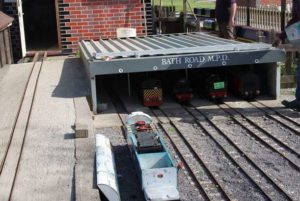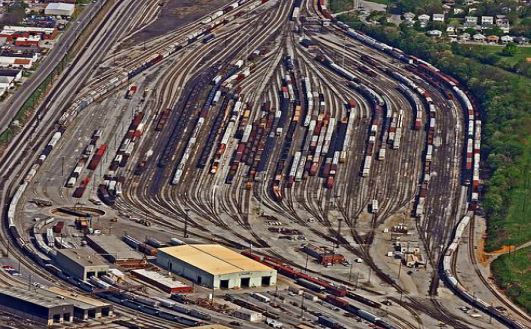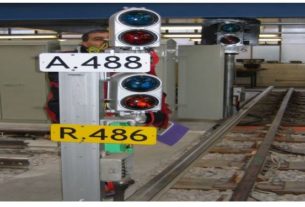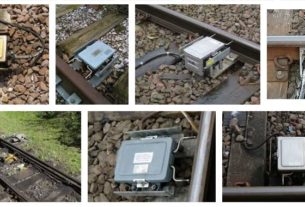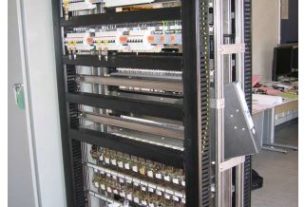Station and Yards Railway Signalling
Definition of Station
1. A railway station or a railroad station and often shortened to just station, is a railway facility where trains regularly stop to load or unload passengers and/or freight.
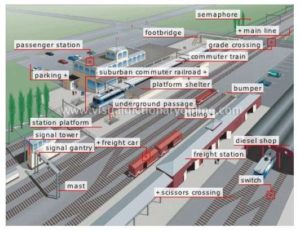
Purpose of Railway station
For exchange of passengers and goods.
1. For control of train movements
2. To enable the trains on a single line track to cross from opposite directions.
3. To enable the following express trains to overtake
4. For taking diesel or coal and water for locomotives
5. For detaching engines and running staff
6. For detaching or attaching of compartments and wagons
7. For sorting of bogies to form new trains, housing of locomotive in loco sheds.
8. In emergencies in ease of dislocation of track due to rains, accidents etc…
9. For repairing engines and changing their direction
10. Railway station are having suitable approach roads from surrounding areas.
Types of Stations
1. Wayside Stations, Junction Stations, Terminal Stations
Wayside Stations
1. In this type arrangements are made for crossing or for overtaking trains. Wayside stations are of the following types.
i.Halt stations ii.Flag Stations iii.Crossing stations.
Halt Stations
1. A halt, is a small station, usually un staffed and with few or no facilities. In some cases, trains stop only on request, when passengers on the platform indicate that they wish to board, or passengers on the train inform the crew that they wish to alight.
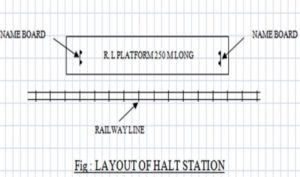
Flag Stations
1. Flag stations describes a stopping point at which trains stop only on an as-need or request basis; that is, only if there are passengers to be picked up or dropped off.
2. These stations have no overtaking or crossing facilities and arrangements to control the movement of trains. These stations have buildings, staff and telegraph facilities.
3. Some of the flag stations have sidings also in the form of loops.
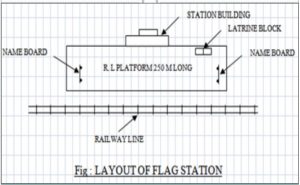
Crossing Stations
1. Provided with facilities for crossing
2. In this type at least one loop line is provided to allow another train if one track is already occupied by a waiting train
3. Generally the train to be stopped is taken on the loop line and the through train is allowed to pass on the main line
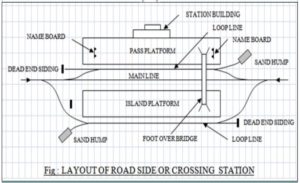
Junction stations
1. At a junction stations, lines from three or more directions meet
2. The stations where a branch line meets the main line are known as junctions.Arrangements in junction stations
3. Facilities for interchange of traffic between main and branch line
4. Facilities to clean and repair the compartments of the trains
5. Facilities for good sidings, engine sheds, turn table etc.
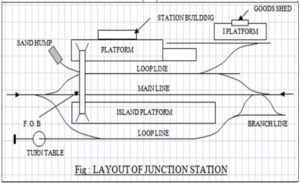
Terminal Stations
1. It is a station where a railway line or one of its branches terminates
2. Facilities required in terminal stations
3. Watering, coaling, cleaning, servicing the engine
4. Turn table for the change of direction of the engine
5. Facilities for dealing goods traffic. Such as marshaling yard, engine sheds, sidings etc.
6. In circulating area, ticket office, restaurant etc are provided and it is directly connected to the road
Terminal Stations
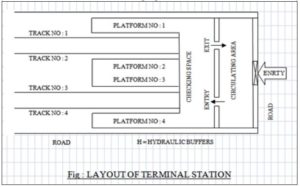
Classification of Stations
Stations can be classified on the basis of their operation as
1. Block stations-Class A, Class B and Class C
2. Non Block Stations-Class D stations or Flag stations
3. Special class stations.
Block Stations
The stations at the end the block sections are called Block stations Authority to proceed is given in the shape of token at these stations.
Class A Station: On these stations the track is cleared up to 400m beyond the home signal for giving permission to approach a train
Class B Station: In such stations, the other signal is provided at about 580m from the home signal
Class C Station: On these stations passengers are not booked. It is simply a block meant for splitting a long block section and to reduce the interval between the successive trains.
Non Block Stations
1. Also known as Class D station or Flag station
2. Situated between two consecutive block stations
3. May not be telegraphically connected to the adjacent stations
4. No equipment or staff is provided for controlling the movements of the trains.
5. Trains are stopped by flag signals only
Special class stations
Stations not coming under block station and non block stations are called special class station
Platforms – Passenger and Goods platforms
1. A railway platform is a section of pathway, alongside rail tracks at a railway station, metro station or tram stop, at which passengers may board or alight from trains or trams.
2. Almost all rail stations have some form of platform, with larger stations having multiple platforms.
3. Platform types include the bay platform, side platform (also called through platform), split platform and the island platform.
4. A bay platform is one at which the track terminates, i.e. a dead-end or siding.
5. A side platform is the more usual type, alongside tracks where the train arrives from one end and leaves towards the other.
6. An island platform has through platforms on both sides; it may be indented on one or both ends, with bay platforms.
Passenger Platform
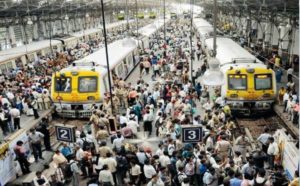
Goods Platform
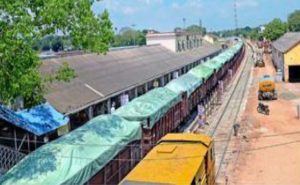
Definition of Yard
1. An area consisting of a network of railway tracks, sidings, and sheds for storing, maintaining, and joining engines and carriages.
2. A yard is defined as a system of tracks laid within definite limits for various purposes such as receiving sorting and dispatch of vehicles.
Railway Yard
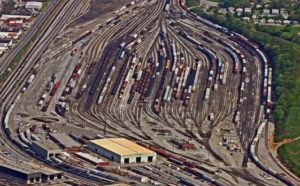
Types of Yards
1. Passenger yards, Goods yards, Marshalling yards, Locomotive yards
Passenger yards
1. Function of passenger yard is to provide all the facilities for the safe movement of passengers.
Facilities in passenger yards
1. Booking office, enquiry office, luggage booking room, cloak room and waiting room for passengers
2. Parking space for vehicles
3. Signals for reception and dispatch of trains
4. Platforms and sidings for shunting facilities
5. Facilities for changing batteries
6. Facilities for passing a through train
7. Washing lines, sick lines facilities
Passenger yards
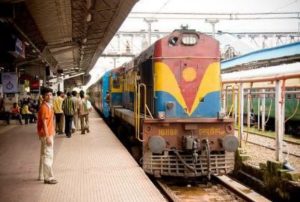
Goods yards
1. A goods station (also known as a goods yard, goods depot or freight station) is, in the widest sense, a railway station which is exclusively or predominantly where goods (or freight) of any description are loaded or unloaded from ships or road vehicles and/or where goods wagons are transferred to local sidings.
2. These are provided for receiving, loading and unloading of goods

Requirements of a goods yard
1. Approach road for movement of goods
2. Sufficient number of platforms for loading and unloading
3. Sufficient number of godowns
4. Booking office
5. Cart weighing machine
6. Cranes for loading and unloading
7. Vacuum testing machine
Marshalling yards
1. Marshalling yard is a railroad yard found at some freight train stations, used to separate railroad cars on to one of several tracks.
2. It is the place where goods wagons received from different centres are sorted out and placed in order to detached at different stations.
3. The marshalling yards are distribution centres.
4. Empty wagons are also kept in marshalling yards.
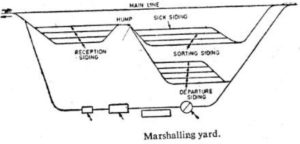
Factors for the efficient functioning of marshalling yards
1. Shunting operations should not disturb the regular trains
2. Should be kept parallel to the running trains
3. Movement of wagons in one direction only
4. Repair facilities should be provided on one or more sidings
5. Connected to all important railway stations
6. Goods yard should be nearer to the marshalling yard
Types of marshalling yards
(i)Flat yard (ii)Gravity yard (iii)Hump yard
Flat yard
1. Flat yards are constructed on flat ground, or on a gentle slope. Freight vehicles are pushed by a locomotive and coast to their required location.
2. A flat yard has no hump, and relies on locomotives for all car movements
Gravity yard
1. The whole yard is set up on a continuous falling gradient and there is less use of shunting engines.
2. Typical locations of gravity yards are places where it was difficult to build a hump yard due to the topography.
3. Gravity yards also have a very large capacity but they need more staff than hump yards and thus they are the most uneconomical classification yards.
Hump-yard
1. These are the largest and most effective classification yards, with the largest shunting capacity—often several thousand cars a day.
2. The heart of these yards is the hump: a lead track on a hill (hump) that an engine pushes the cars over.
3. Single cars, or some coupled cars in a block, are uncoupled just before or at the crest of the hump, and roll by gravity onto their destination tracks.
4. A hump yard has a constructed hill, over which freight cars are shoved by yard locomotives, and then gravity is used to propel the cars to various sorting tracks.
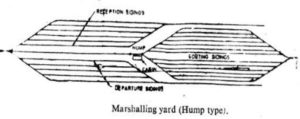
Locomotive yards
1. This is the yard which houses the locomotives for various facilities such as watering, fueling, cleaning, repairing, servicing etc.
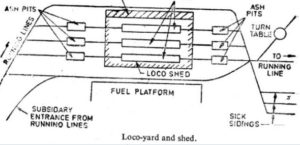
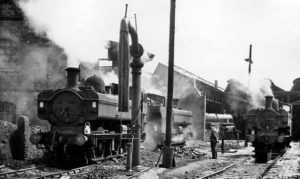
Requirements of a locomotive yard
1. Should be located near the passenger and goods yards
2. Water column
3. Engine shed, Ash pit, inspection pit, repair shed, turn table
4. Hydraulic jack for lifting operations
5. Over head tank and loco well
6. Sick siding
7. Place for future expansion
Level crossings
1. A level crossing (a primarily British term; usually known as a railroad crossing in the United States) is an intersection where a railway line crosses a road or path at the same level
2. Other names include railway crossing, grade crossing, road through railroad, and train crossing.
3. The type of facilities provided at level crossing depends up on the following
4. Nature of the road
5. Nature of the traffic on road
6. Number of trains passing over the level crossing
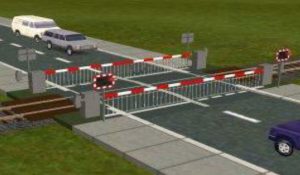
Classification of level crossing
1. Special class – Traffic is exceptionally heavy
2. A class – On grand trunk roads
3. B class – Metelled roads
4. C class – unmetelled roads
5. D class – used for cattle‘s as ramps and pedestrians only
Station Equipments
1. For efficient running of trains, safety of traffic, repairing, cleaning, examining of locomotives etc. some equipment and machinery is needed. These equipment’s are known as station equipment
Engine sheds
1. Railway engine sheds were provided at terminal stations, junctions, and other locations around the railway.
2. They provided covered accommodation for servicing locomotives – this could be simple tasks such as changing brake blocks to more complex task that involved dismantling and repairing the engine.
3. Types of engine sheds are (i) Rectangular type (ii) Circular type
Rectangular type engine shed
1. In this type of engine shed, two parallel tracks are laid, which meet at one or both the ends.
2. The engine can come from one end and leave the shed in other end
3. They need more space; they are widely used in India
